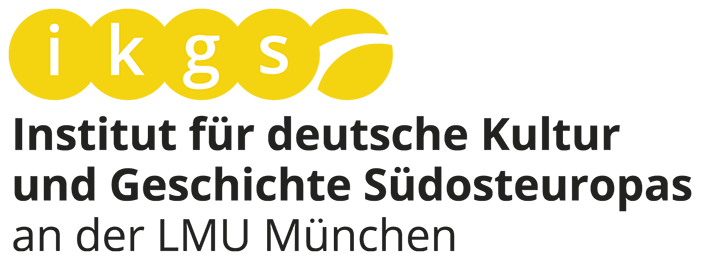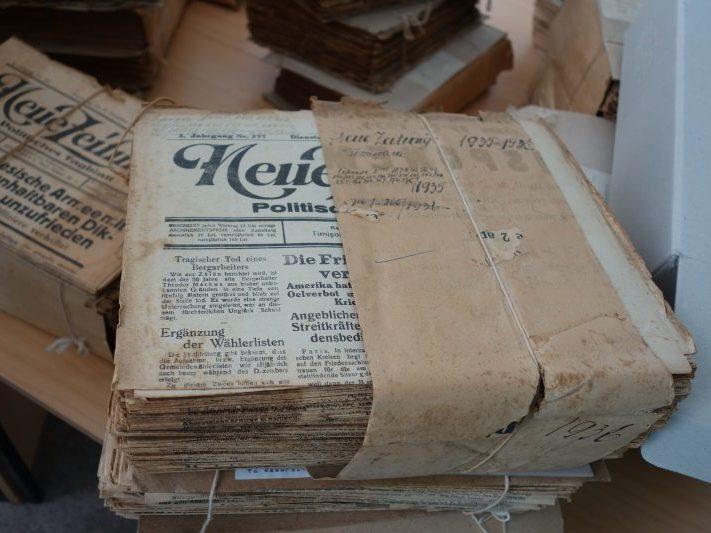The project “Paper Bridges” at the Institute for German Culture and History in South-East Europe (IKGS) involved the treatment and conservation of six shelf-meters of original periodicals to ensure their permanent preservation. These German newspapers from Romania form bridges between past and present, old and new homes, and between everyday culture and science.
Text
The importance of cultural heritage protection in libraries
The fire at the Duchess Anna Amalia Library, in Weimar in 2004, and the collapse of the Cologne City Archives in 2009 are just two examples in recent history that have raised public awareness of the need to protect cultural assets. However, unforeseen disasters are not the only danger to library and archive materials. Quantitatively, the greatest damage is caused insidiously by paper decay, acid corrosion, storage damage, mold and pest damage. Most institutions do not allow for the protection of cultural assets in their day-to-day library budgets. Particularly for small institutions with few staff, the preservation of the stock is often difficult to manage in addition to everyday business. This is where the work of the Coordination Office for the Preservation of Written Cultural Heritage comes in.
Coordination Office for the Preservation of the Written Cultural Heritage (KEK)
The Coordination Office for the Preservation of the Written Cultural Heritage (KEK) is financed by the Federal Government Commissioner for Culture and the Media (BKM) and the Cultural Foundation of the German States and is located at the Berlin State Library. Its goal is the permanent preservation of original works of written cultural heritage. Since 2011 it has been involved in four areas of activity:
- Collecting and evaluating findings on the preservation of written cultural assets
- Forming networks to encourage cooperation between institutions involved in preservation work
- Raising public awareness of the threats facing works of written heritage
- Supporting model projects nationwide
About the project and financing
Since 2017, there has also been an annual call for proposals for the special program “Conservation” (“Bestandserhaltung”), for which the library of the Institute for German Culture and History in South-East Europe (IKGS) submitted its first application in the summer of 2018. The special program funded conservation measures that can be carried out in mass procedures, such as mass deacidification, restoration and protective packaging. In addition, the holdings to be restored must be of supra-regional importance from a historical or scientific point of view, i.e. valuable, unique works or rarities or works that are hard to replace. Furthermore, there must be evidence of a direct threat, such as the imminent decay of acidic paper. With the help of project funding from the KEK, it has now been possible to save such stocks from decay.
**The “Paper Bridges”: Historical German newspapers from Romania **
For the project, 26 newspapers and magazines were selected from the IKGS inventory, all of which reflect everyday culture in the German settlement areas in Romania, including school programs, pocket calendars and tabloids. The German-language newspapers and magazines are either not preserved in their respective areas of origin or are rarely kept and catalogued in publicly accessible libraries. Therefore, the preservation and restoration of these rare originals, also with a view to later digitization, was urgently needed. The selected holdings date back to the period before 1945, when industrially manufactured, acidic paper was used. Storing such low pH paper for several decades destroys the cellulose chains and causes it to decompose.
**Carrying out conservation and restoration work **
Mass deacidification processes can neutralize the acids in the paper and quadruple its life span. In addition, the newspapers had been damaged through being stored, since some of them had only been kept in temporary bundles for over half a century.
Their restoration has made them usable again for scientific research. For this purpose, it was also necessary to fill in missing sections and close tears in the paper. Loose bindings were repaired and individual journals were rebound. In total, 220 kilograms of newspapers and magazines were deacidified and restored by an external service provider. The newspapers were packed in acid-free archive boxes. In order to document the mass deacidification of the stocks, the inventory records in the periodicals database (ZDB) are supplemented with this information. In addition, all deacidified holdings were marked with stickers on the cover or on the archive boxes to prevent multiple deacidification in further projects.
Externe Links
External Image






